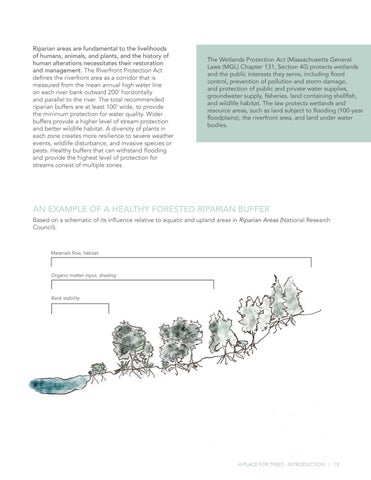Riparian areas are fundamental to the livelihoods of humans, animals, and plants, and the history of human alterations necessitates their restoration and management. The Riverfront Protection Act defines the riverfront area as a corridor that is measured from the mean annual high water line on each river bank outward 200’ horizontally and parallel to the river. The total recommended riparian buffers are at least 100’ wide, to provide the minimum protection for water quality. Wider buffers provide a higher level of stream protection and better wildlife habitat. A diversity of plants in each zone creates more resilience to severe weather events, wildlife disturbance, and invasive species or pests. Healthy buffers that can withstand flooding and provide the highest level of protection for streams consist of multiple zones.
The Wetlands Protection Act (Massachusetts General Laws (MGL) Chapter 131, Section 40) protects wetlands and the public interests they serve, including flood control, prevention of pollution and storm damage, and protection of public and private water supplies, groundwater supply, fisheries, land containing shellfish, and wildlife habitat. The law protects wetlands and resource areas, such as land subject to flooding (100-year floodplains), the riverfront area, and land under water bodies.
AN EXAMPLE OF A HEALTHY FORESTED RIPARIAN BUFFER Based on a schematic of its influence relative to aquatic and upland areas in Riparian Areas (National Research Council).
Materials flow, habitat
Organic matter input, shading
Bank stability
A PLACE FOR TREES - INTRODUCTION | 13







